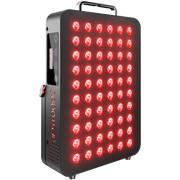Light is at the essence of human life, governing some of the most vital processes in the body from sleep to emotions. Red light therapy stands among the many other kinds of light therapies touted for having some great mood enhancement benefits. In today's blog post, we will explain what red light therapy is, how it works, and why such a hack can really help with improving your mood.

What Is Red Light Therapy and How Does It Work?
Red light therapy (RLT), or low-level laser therapy (LLLT), refers to the exposure of the body to low levels of red or near-infrared light for therapeutic purposes. In general, red light therapy uses wavelengths ranging from 630–660 nm for red light and 810–850 nm for near-infrared light. Unlike ultraviolet (UV) light, red light exposure is safe and non-invasive, set in very narrow bandwidths of specific wavelengths.
Red light therapy enhances body functions through skin penetration by stimulating mitochondria, also known as the powerhouse of the cells. This energizes the mitochondria to boost the production of ATP, which is the energy currency of the cell. Due to the high production of ATP in a cell, the function of the cell increases, leading to healing and repair.
Why is Red Light Therapy Effective in Lifting the Mood?
Red light therapy's mood-boosting effects are attributed to several potential mechanisms:
- Increased Blood Flow: Red light therapy improves blood flow by increasing the number of new capillaries, which bring more oxygen and nutrients to the brain. RLT directly helps to maintain healthy brain functioning and regulate moods.
- Lower Inflammation: Chronic inflammation is associated with mood disorders like depression. Since red light therapy has an anti-inflammatory effect, it may relieve symptoms of depression and anxiety by lowering the inflammatory markers in the brain.
- Enhanced Cellular Energy Production: Better energy levels in cells could enhance overall brain function, hence mood and cognitive function. A study published in The Journal of Affective Disorders found improvement in the mood of the patients and diminished depressive symptoms in patients with seasonal affective disorder after red light therapy.
How to Use Red Light Therapy for Mood Enhancement
Choosing Your Red Light Therapy Device
Red light therapy (RLT) devices come in various forms, including handheld units, larger panels, and even full-body beds. When you're focusing on mood enhancement, it's best to use a device that can easily target your face and upper body since these areas are key for the mood-related benefits.
How Long and How Often?
For starters, aim for RLT sessions that last between 10 to 20 minutes. This is enough time for the light to penetrate the skin and stimulate cellular activity without overexposure. To gauge how your mood responds, begin with 3 to 4 weekly sessions. Adjust as necessary based on how you feel. Many users report a noticeable boost in mood after a few weeks of consistent use.
Sticking With It
Just like any wellness routine, consistency is key. Think of RLT as a regular part of your mental health toolkit-just like exercise or meditation. Integrating it into your daily routine can help manage mood swings and contribute to emotional balance over time.
Positioning Yourself Correctly
The distance between you and the light source matters. Usually, standing or sitting about 6 to 12 inches away from the light ensures you're getting the right amount of exposure—close enough to be effective, but not so close that it's uncomfortable. Make sure the light covers your entire face and, if possible, the upper chest area, for optimal results.
If, at any point, you feel discomfort or have concerns, take a break and consult with a healthcare provider who has experience with red light therapy.

Success Stories
Several people have tested red light therapy for mood improvement, and their testimonials are vast. Jane, a 35-year-old woman challenged with chronic anxiety, felt calm and balanced when treated with red light therapy. After continuous application, in a few weeks, her mood and general well-being remarkably improved.
Red light therapy can be amplified if combined with moderate physical activity and overall dietary habits to calm the mind. John is a 42-year-old teacher who has just integrated red light therapy into his morning routine and, combined with meditation, felt more positive and energized the whole day.
A lot of users might have some issues with time and general consistency Setting a specific time every day for your red light therapy session would be very helpful to help get over these obstacles. Think of it as an integral part of your daily routine, like brushing your teeth. Also, using smaller, portable devices may help you stay consistent while traveling.
What Are the Safety Guidelines for Using Red Light Therapy?
Recognizing Potential Side Effects
While red light therapy is largely safe, there are a few side effects you should be aware of. Some individuals may experience mild headaches or eyestrain, particularly if they are new to the therapy or have light sensitivity. Skin redness can also occur, similar to the flush from mild sun exposure, which should dissipate shortly after treatment. If any of these symptoms last longer than usual or cause discomfort, it's best to pause the therapy and consult with a healthcare professional.
Identifying Who Should Steer Clear
Red light therapy isn't for everyone. Users with conditions that make them sensitive to light, such as lupus or porphyria, should avoid it. The same goes for individuals on medications that increase light sensitivity, like certain types of antibiotics, antipsychotics, or herbal supplements such as St. John's Wort. Always check with your healthcare provider before starting red light therapy if you have any known sensitivities or are taking medication.
Consultation Before Commencement
Before diving into red light therapy, a consultation with a healthcare provider is essential. This step is especially important for those with pre-existing medical conditions. A qualified professional can offer guidance on whether RLT is suitable for your specific health needs, advise on safe practices, and help you understand what to expect from the therapy.
Safeguarding Your Eyes During Therapy
Protecting your eyes during red light therapy sessions is a precautionary measure worth taking. Although RLT isn't as intense as UV light, using safety goggles or simply closing your eyes can prevent potential strain. This small step helps ensure a comfortable session, allowing you to relax and benefit from the therapy without worry.
Being Mindful of Skincare Products
The skincare products you use may not always be compatible with red light therapy. Some formulations can increase sensitivity to light or have adverse reactions when exposed to it. It's important to read product labels carefully and, if necessary, seek advice from a dermatologist to determine which products are safe to use alongside RLT.
Choosing Quality Devices and Following Usage Guidelines
Ensuring that your red light therapy device is up to standard is crucial. Select devices that are FDA-cleared or meet equivalent safety regulations to guarantee their efficacy and safety. Moreover, adhering to the manufacturer's instructions on usage - like how long and how often to use the device, proper distance during sessions, and maintenance requirements—will help maximize benefits and minimize risks.
Post-Therapy Tips
After completing a red light therapy session, it's good practice to stay hydrated by drinking water to support your body's response. Keep an eye on your skin following treatment to monitor for any unexpected reactions, such as worse redness or irritation, and seek advice if such reactions occur. As with any therapeutic procedure, being observant and responsive to your body's reactions will keep you safe and healthy.
Conclusion
Red light therapy is immense in its potential to be a non-invasive, drug-free approach for improving one's mood. It may work wonders on mental well-being where there is increased blood flow, reduced inflammation, and enhanced cellular energy production. While providing these benefits, scientific research and a mountain of anecdotal evidence back them up; still, one needs to apply it regularly and in the right form to derive maximum benefits from red light therapy.
References
[1]Glass GE. Photobiomodulation: The Clinical Applications of Low-Level Light Therapy. Aesthet Surg J. 2021 May 18;41(6):723-738. https://pubmed.ncbi.nlm.nih.gov/33471046/
[2] Reeves GM, Nijjar GV, Langenberg P, Johnson MA, Khabazghazvini B, Sleemi A, Vaswani D, Lapidus M, Manalai P, Tariq M, Acharya M, Cabassa J, Snitker S, Postolache TT. Improvement in depression scores after 1 hour of light therapy treatment in patients with seasonal affective disorder. J Nerv Ment Dis. 2012 Jan;200(1):51-5. https://pubmed.ncbi.nlm.nih.gov/22210362/
[3] Michalon M, Eskes GA, Mate-Kole CC. Effects of light therapy on neuropsychological function and mood in seasonal affective disorder. J Psychiatry Neurosci. 1997 Jan;22(1):19-28. https://pubmed.ncbi.nlm.nih.gov/9002389/
[4] Tao L, Jiang R, Zhang K, Qian Z, Chen P, Lv Y, Yao Y. Light therapy in non-seasonal depression: An update meta-analysis. Psychiatry Res. 2020 Sep;291:113247. https://pubmed.ncbi.nlm.nih.gov/32622169/
Read More
- Red Light Therapy| Improve Sleep & Wellness – BESTQOOL
- Red Light Therapy | Unlock Wellness & Beauty Benefits – BESTQOOL
- Red Light Therapy Dosing Guide – BESTQOOL
- Red Light Therapy for Newborn Sleep | Enhance Baby's Rest – BESTQOOL
- Red Light Therapy and the Ketogenic Diet: How They Work Together and W – BESTQOOL














 Small
Small

 Moderate
Moderate

 Moderate
Moderate

 Moderate
Moderate

 Full
Full



